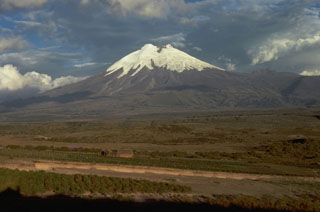Report on Cotopaxi (Ecuador) — 7 December-13 December 2022
Smithsonian Institution / US Geological Survey
Weekly Volcanic Activity Report, 7 December-13 December 2022
Managing Editor: Sally Sennert.
Please cite this report as:
Global Volcanism Program, 2022. Report on Cotopaxi (Ecuador) (Sennert, S, ed.). Weekly Volcanic Activity Report, 7 December-13 December 2022. Smithsonian Institution and US Geological Survey.
Cotopaxi
Ecuador
0.677°S, 78.436°W; summit elev. 5911 m
All times are local (unless otherwise noted)
IG reported that the low-level eruption at Cotopaxi continued during 7-13 December characterized by steam-and-gas emissions and occasional ash emissions. Sulfur dioxide emissions measured by satellite almost daily averaged 665-2,745 tons per day. Steam-and-gas emissions observed during 7-10 December rose as high as 2 km above the crater rim and drifted SW, W, and NW. Ash emissions during 0758-0816 on 8 December rose 1 km and drifted WNW. The Washington VAAC issued three advisories noting that ash rose 800-1,100 m and drifted W. A tremor signal that started at 0832 on 9 December was probably related to gas-and-ash emissions, though cloudy weather conditions prevented visual confirmation. During the night of 9-10 December several steam-and-ash emissions were identified in satellite images rising as high as 1.1 km and drifting NW. Minor ashfall was reported in Conocoto-Pichincha in the morning of 10 December. At 0930 on 11 December the seismic stations recorded a signal related to gas-and-ash emissions that rose 2 km and drifted W. Ash fell in Control Caspi, located at the S entrance to Parque Nacional Cotopaxi. Several gas-and-steam emissions with low ash content were visible that afternoon and during the morning of 12 December rising as high as 500 m and drifting W. Servicio Nacional de Gestión de Riesgos y Emergencias (SNGRE) maintained the Alert Level at Yellow (the second lowest level on a four-color scale).
Geological Summary. The symmetrical, glacier-covered, Cotopaxi stratovolcano is Ecuador's most well-known volcano and one of its most active. The steep-sided cone is capped by nested summit craters, the largest of which is about 550 x 800 m in diameter. Deep valleys scoured by lahars radiate from the summit of the andesitic volcano, and large andesitic lava flows extend to its base. The modern edifice has been constructed since a major collapse sometime prior to about 5,000 years ago. Pyroclastic flows (often confused in historical accounts with lava flows) have accompanied many explosive eruptions, and lahars have frequently devastated adjacent valleys. Strong eruptions took place in 1744, 1768, and 1877. Pyroclastic flows descended all sides of the volcano in 1877, and lahars traveled more than 100 km into the Pacific Ocean and western Amazon basin. Smaller eruptions have been frequent since that time.
Sources: Instituto Geofísico-Escuela Politécnica Nacional (IG-EPN), Servicio Nacional de Gestión de Riesgos y Emergencias (SNGRE)

